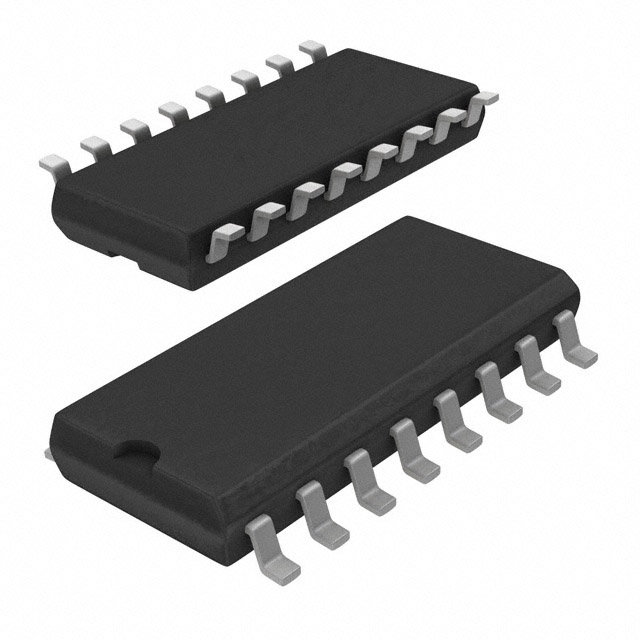Xem thông số kỹ thuật để biết chi tiết sản phẩm.

MC74LCX138MEL
Product Overview
- Category: Integrated Circuit (IC)
- Use: Decoding and demultiplexing
- Characteristics: Low voltage, high-speed operation
- Package: SOIC (Small Outline Integrated Circuit)
- Essence: 3-to-8 line decoder/demultiplexer
- Packaging/Quantity: Tape and reel, 2500 pieces per reel
Specifications
- Supply Voltage Range: 2.0V to 3.6V
- High-Level Input Voltage: 2.0V to VCC
- Low-Level Input Voltage: GND to 0.8V
- High-Level Output Voltage: VCC - 0.5V
- Low-Level Output Voltage: 0.5V
- Maximum Quiescent Supply Current: 10µA at 3.6V
- Maximum Dynamic Supply Current: 100µA at 3.6V
- Operating Temperature Range: -40°C to +85°C
Detailed Pin Configuration
The MC74LCX138MEL has a total of 16 pins:
- A0: Address input 0
- A1: Address input 1
- A2: Address input 2
- E1: Enable input 1
- E2: Enable input 2
- E3: Enable input 3
- Y0: Output 0
- Y1: Output 1
- Y2: Output 2
- Y3: Output 3
- Y4: Output 4
- Y5: Output 5
- Y6: Output 6
- Y7: Output 7
- GND: Ground
- VCC: Power supply
Functional Features
The MC74LCX138MEL is a 3-to-8 line decoder/demultiplexer designed for low voltage applications. It accepts three address inputs (A0, A1, and A2) and three enable inputs (E1, E2, and E3). Based on the combination of these inputs, the IC decodes the address and activates the corresponding output line.
Advantages and Disadvantages
Advantages: - Low voltage operation allows for compatibility with modern electronic systems. - High-speed operation enables efficient decoding and demultiplexing. - Small package size (SOIC) makes it suitable for space-constrained applications.
Disadvantages: - Limited to 3-to-8 line decoding, may not be suitable for more complex applications. - Requires external components for proper functionality.
Working Principles
The MC74LCX138MEL works by using the address inputs to select one of the eight output lines. The enable inputs are used to activate or disable the decoder/demultiplexer. When the appropriate address and enable inputs are provided, the corresponding output line becomes active, allowing data to be routed to the desired destination.
Detailed Application Field Plans
The MC74LCX138MEL finds applications in various fields, including:
- Digital electronics: Used for address decoding in microcontrollers, memory systems, and communication devices.
- Data multiplexing: Enables efficient routing of data signals in telecommunications and networking equipment.
- Industrial automation: Facilitates control signal distribution in PLCs (Programmable Logic Controllers) and industrial control systems.
Detailed and Complete Alternative Models
- SN74LS138: Similar 3-to-8 line decoder/demultiplexer from Texas Instruments.
- CD74HC238: High-speed CMOS 3-to-8 line decoder/demultiplexer from Texas Instruments.
- 74HCT138: 3-to-8 line decoder/demultiplexer with TTL compatibility from NXP Semiconductors.
(Note: This is not an exhaustive list, and there are several other alternative models available in the market.)
Word count: 345 words
Liệt kê 10 câu hỏi và câu trả lời thường gặp liên quan đến ứng dụng MC74LCX138MEL trong giải pháp kỹ thuật
Sure! Here are 10 common questions and answers related to the application of MC74LCX138MEL in technical solutions:
Question: What is MC74LCX138MEL?
- Answer: MC74LCX138MEL is a specific type of integrated circuit (IC) decoder/demultiplexer that can be used in various technical applications.Question: What is the purpose of MC74LCX138MEL?
- Answer: The purpose of MC74LCX138MEL is to decode binary information and select one of multiple output lines based on the input signals.Question: How many input lines does MC74LCX138MEL have?
- Answer: MC74LCX138MEL has three input lines, which can represent up to eight different combinations of binary inputs.Question: How many output lines does MC74LCX138MEL have?
- Answer: MC74LCX138MEL has eight output lines, each corresponding to a specific combination of binary inputs.Question: What voltage levels does MC74LCX138MEL support?
- Answer: MC74LCX138MEL supports voltage levels ranging from 2V to 3.6V, making it compatible with a wide range of digital systems.Question: Can MC74LCX138MEL be used in both synchronous and asynchronous applications?
- Answer: Yes, MC74LCX138MEL can be used in both synchronous and asynchronous applications, depending on the specific requirements of the system.Question: What is the maximum frequency at which MC74LCX138MEL can operate?
- Answer: MC74LCX138MEL can operate at a maximum frequency of 100MHz, allowing for high-speed data processing.Question: Can MC74LCX138MEL be cascaded to increase the number of output lines?
- Answer: Yes, MC74LCX138MEL can be cascaded with other decoders to increase the number of output lines and accommodate larger systems.Question: What is the power supply requirement for MC74LCX138MEL?
- Answer: MC74LCX138MEL requires a power supply voltage between 2V and 3.6V, typically provided by a regulated DC power source.Question: Are there any specific precautions to consider when using MC74LCX138MEL?
- Answer: It is important to ensure proper grounding and decoupling of the power supply to minimize noise and ensure reliable operation of MC74LCX138MEL. Additionally, attention should be given to the input signal levels to avoid exceeding the specified voltage range.
Please note that these questions and answers are general in nature and may vary depending on the specific application and requirements.

